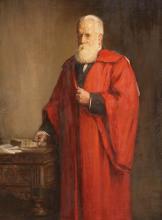Andrew Seth Pringle-Pattison was born Andrew Seth on 20 December 1856 in the city of Edinburgh. His parents were Margaret and Smith Kinmot Seth, a bank clerk. He was schooled at the Royal High School in his home city and went on to achieve first class honours in classics and philosophy at the University of Edinburgh (1873-1878). As a postgraduate Seth spent two years in Germany, studying in Berlin, Jena and Göttingen. He returned to Edinburgh in 1880.
It was there he obtained his first position, serving as an assistant to Alexander Campbell Fraser, in which he would remain for three years. There he produced, in conjunction with R. B. Haldane, pioneering work on the British neo-Hegelian movement. It was this that secured him the professorship of Logic and Philosophy at University College, Cardiff. In 1887 Seth moved to St Andrews to take up a role as professor of logic, rhetoric, and metaphysics. In 1891 he moved again, returning to Edinburgh as professor of logic and metaphysics. He remained there until 1919. In 1898 he inherited a country estate near Selkirk, as a result of which he took the name Pringle-Pattison.
Pringle-Pattison’s early works, such as The Development from Kant to Hegel (1882) and his and Haldane’s Essays in Philosophical Criticism (1883), betray a strong inclination towards Hegelian idealism. In this phase of his thought, he criticized Kant from a Hegelian perspective. He suggested that the self-consciousness of Hegel’s idealism solved what he took to be a fundamental problem for Kant, namely that in holding the mind to be distinct from that which acted upon it, access to noumena through phenomena was effectively ruled out.
As his thought developed, however, he rejected the absolute idealism of Hegel, returning to a Kantian approach which located self-consciousness in individual selves. We find this in his later works such as Hegelianism and Personality (1887) and The Idea of God in the Light of Recent Philosophy (1917), in which he attempts to reconcile his moralistic individualism and realism about the external world with what he referred to as his ‘larger’ idealism. Though his approach had considerable appeal to many of his contemporaries, it is generally held that the tensions in his thought were never quite satisfactorily reconciled.
After Kant to Hegel and Essays in Philosophical Criticism, he published two lecture series, sponsored by A. J. Balfour, as Scottish Philosophy (1885) and Hegelianism and Personality, which became two of his most important books. Scottish Philosophy, subtitled A Comparison of the Scottish and German Answers to Hume, is an exceptional exposition of Locke, Berkeley, Hume, Kant and Reid, with felicitous criticisms of each from Pringle-Pattison. Reid, the founder of the Scottish common-sense philosophy, argued against Hume’s scepticism by maintaining that the external world, personal identity and God were the three natural beliefs that philosophy could never challenge, and Pringle-Pattison tried to explain the interactions of these three beliefs in the volume. Hegelianism and Personality is a critique of the philosophical development of Kant, neo-Kantianism, Agnosticism and Hegelianism, in which Pringle-Pattison broke ranks with the Hegelians by locating self-consciousness in individual persons rather than in the Absolute. A third Balfour lecture series on realism, delivered in 1891, was published in Philosophical Review (1892-1893), and posthumously as The Balfour Lectures on Realism (1933).
Pringle-Pattison’s methodology was one of ‘construction through criticism’, with which he tried to find the via media between the unity of objective idealism on the one hand, and the natural realism of the Scottish common-sense philosophy on the other. Governing his philosophical enquiry was a higher aim, which Pringle-Pattison stated in his inaugural lecture at Edinburgh in 1891 as ‘The complete explanation of anything is only reached when we are able to view it in the light of a purpose, of which it forms an integral part or element. Philosophy therefore stands or falls with the possibility of discovering a reasonable meaning or end in the universe. Every true philosophy is in this sense an attempted theodicy—the vindication of a divine purpose in things. Philosophy is therefore necessarily teleological’.
Pringle-Pattison’s writings represent his intellectual biography and cover a wide range of modern philosophy: logic, metaphysics, ethics and religion. Philosophy as an attempt in theodicy was evidenced by Pringle-Pattison’s later writings. Lectures delivered at Princeton in 1896 were published as Two Lectures on Theism (1902), followed by Philosophical Radicals (1907). He was twice a Gifford Lecturer; the Aberdeen series (1912-1913) resulted in The Idea of God in the Light of Recent Philosophy (1917), and the double series in Edinburgh (1921-1923) was published as The Idea of Immortality (1922) and Studies in the Philosophy of Religion (1930). The corpus of lectures represents a significant contribution to rational theism, with the Edinburgh Gifford Lectures accepted as amongst the best of the apologetics of its kind.
In 1884 Pringle-Pattison married Eva Stropp, whom he had met in Berlin. The couple had four sons (the youngest killed in action in 1916), and three daughters (the eldest died in infancy). In 1898 the bequest of the widow of a distant relative, a country estate (The Haining, Selkirkshire) together with 7000 acres, turned the then-Andrew Seth into a Pringle-Pattison and a laird. Eva died in 1928, a loss that Pringle-Pattison never recovered from. He died at The Haining on 1 September 1931 and was buried in Morningside cemetery, Edinburgh.



